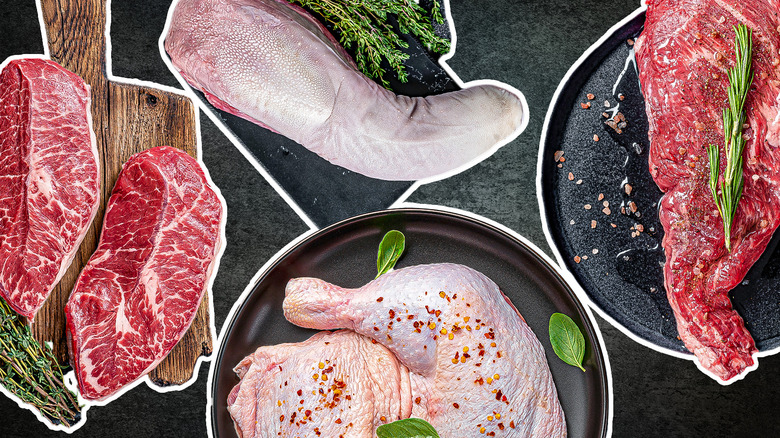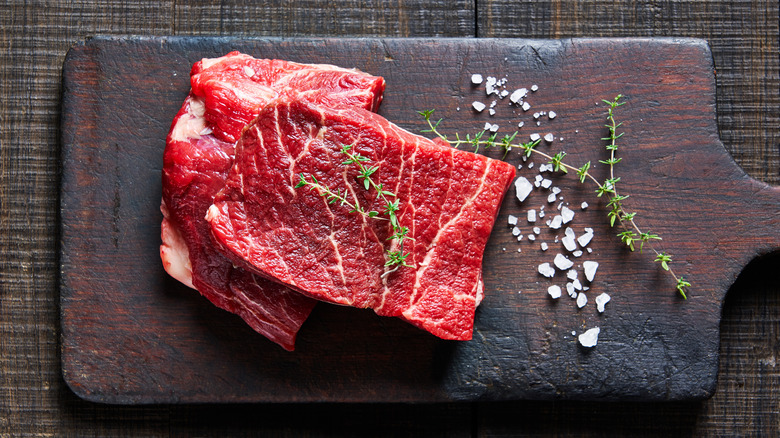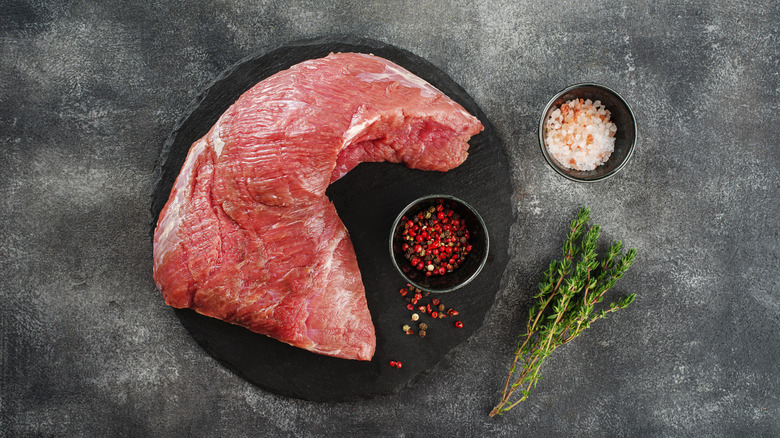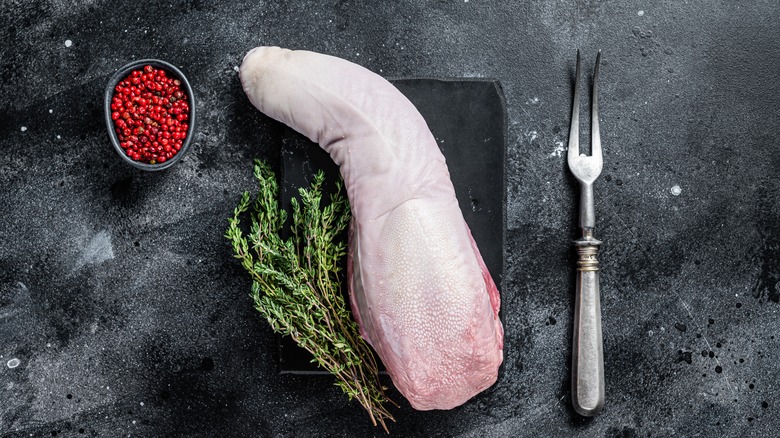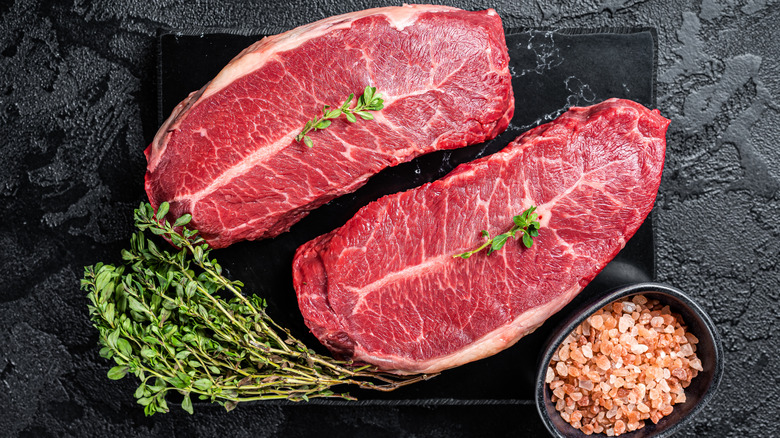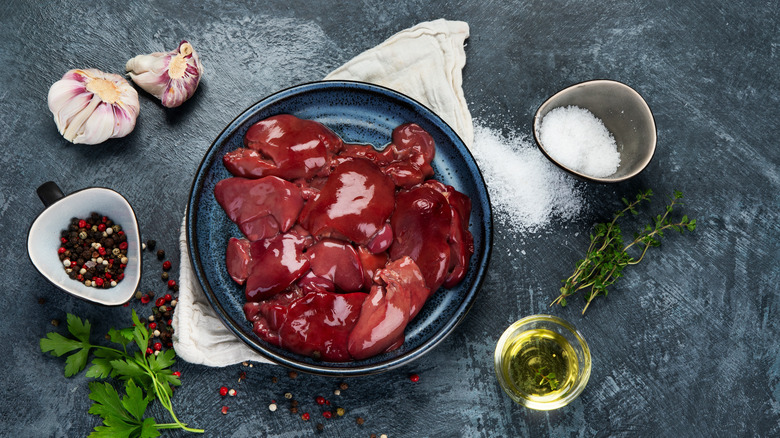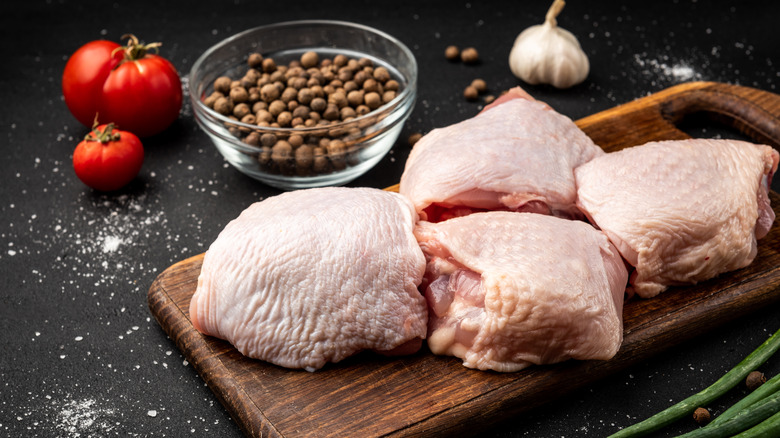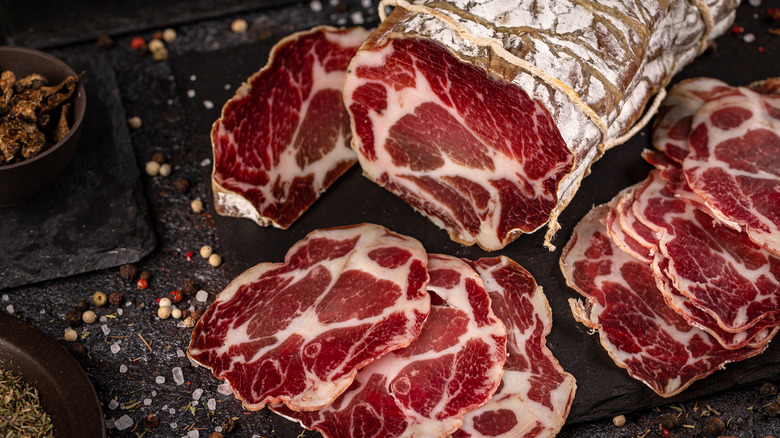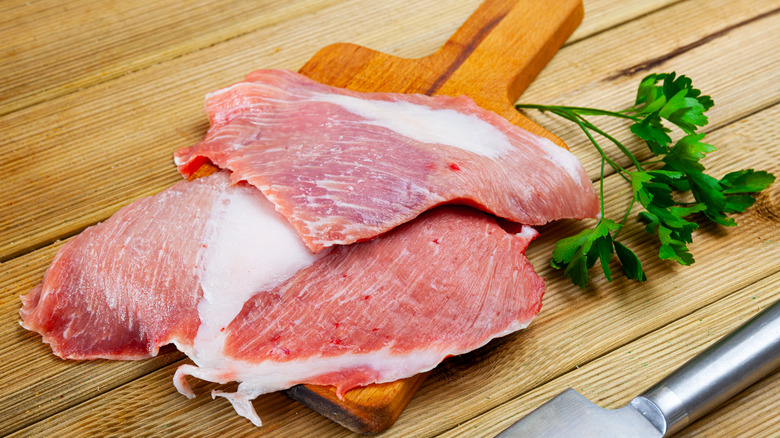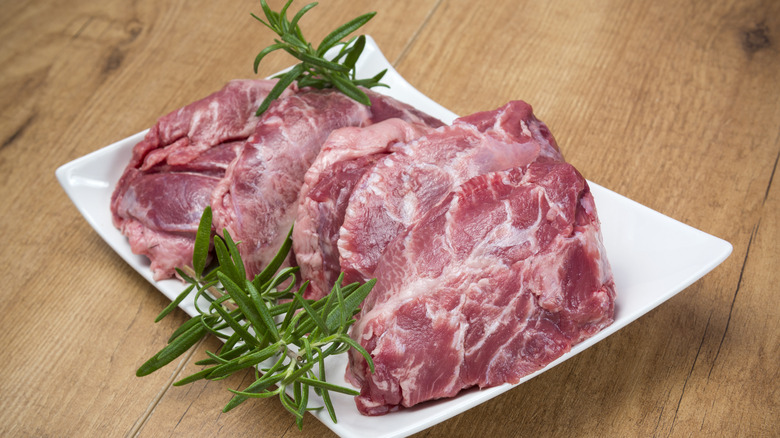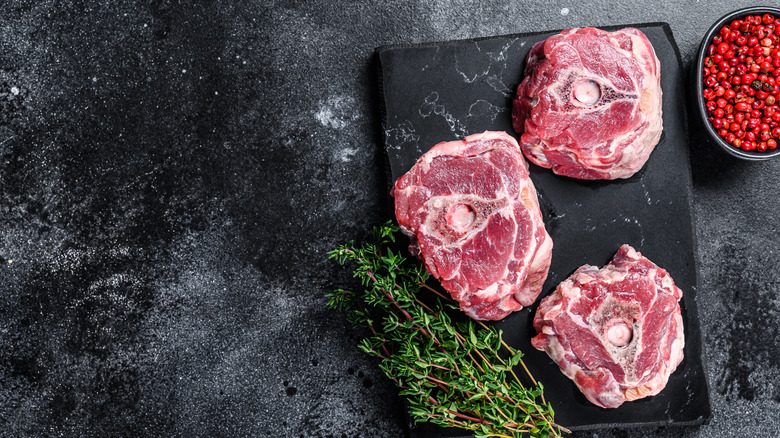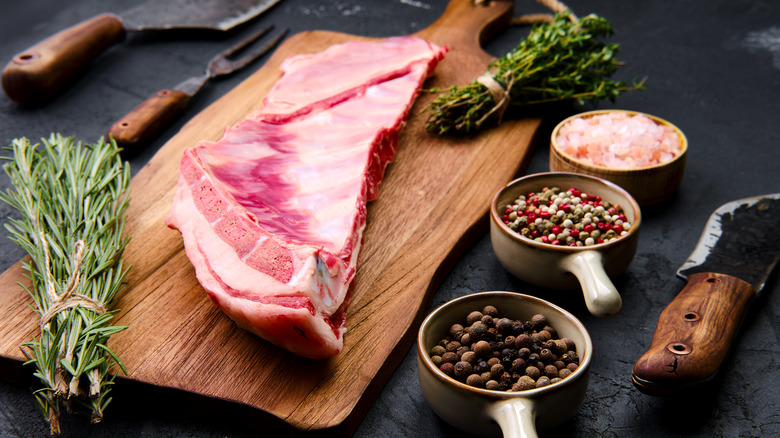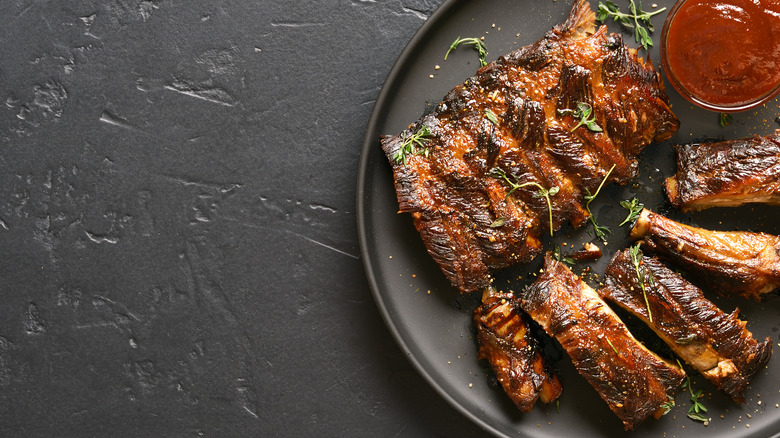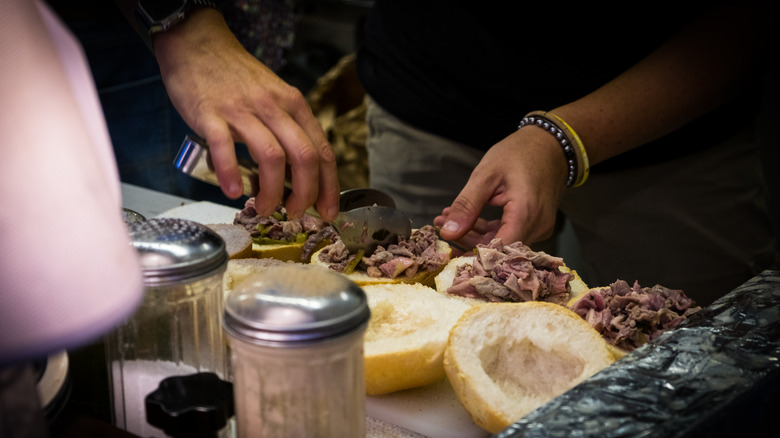13 Underrated Cuts Of Meat You Should Be Eating
Rising prices over the past few post-pandemic years have hit wallets hard, especially for foodies. According to the Bureau of Labor Statistics, food costs are up 6.7% year over year, meaning that you might want to think twice about reaching for ribeyes on your next trip to the grocery store.
Luckily, it's not all bad news. Thrifty shopping doesn't have to mean cutting back on flavor — on the contrary, it's an excuse to experiment in the kitchen. Cheaper and lesser-known meat cuts are often less expensive due to lower demand. It doesn't mean these cuts are lower quality, just that fewer people know what to do with them.
Offal, for example, has long been hailed for both its nutritional and culinary value. In other words, it's been eaten out of necessity as a cheap protein source, like oxtail in Jamaican cuisine, but also as a delicacy like foie gras, a staple at any white-tablecloth French establishment. Ultimately, it all comes down to preparation. Next time you find yourself looking to pinch a few pennies or need some culinary inspiration, try one of these lesser-known cuts. From chicken thighs to pork cheeks, these snout-to-tail selections won't disappoint.
Flat iron steak
Looking for an easy-to-prepare, grillable piece of beef that won't break the bank? Meet the flat iron steak. Butchered from the fatty part of the chuck (aka, the shoulder) of the steer, the flat iron is a more flavorful and tender cut than the similarly shaped flank steak. Thanks to its lesser-used location on the cow, the shoulder-cut steak features the best of both worlds: It's fairly lean with evenly distributed marbling.
The prep is the key to getting a tender, juicy steak out of this inexpensive cut. While the beefy flat iron is delicious on its own, it can be further elevated with a nice marinade applied either before or after grilling — that's right, reverse-marinating is a thing and the perfect party trick for procrastinators. Whether or not you choose to marinate, salting the meat in advance is crucial for a well-seasoned steak.
When it comes time to cook, whip out your trusty cast-iron skillet or head for the grill. The trademark thinness of a flat iron steak makes it a quick-cooking cut and an ideal dish for a crowd. Sear the steak for a few minutes on each side until it reaches your preferred doneness, though with its muscular makeup, cooking much over medium isn't recommended. As with any piece of meat, allow the flat iron to rest before slicing it thin and serving.
Tri-tip
Another lean, grill-friendly option, tri-tip gets its name from the triangle-shaped roast cut from the bottom sirloin, a notoriously tough part of the cow typically avoided by steak connoisseurs. With its light marbling, however, the tri-tip is a surprisingly tender cut, especially when shown a little love prior to cooking.
Some see a lean steak as flavorless, while others find it an exciting culinary challenge. Tri-tip plays well with myriad marinades, dry rubs, and other seasonings, making it a wonderfully neutral base for testing new flavor combinations. The less-common cut is also on the inexpensive side, so you can experiment to your heart's (or wallet's) content. Feeling overwhelmed by the endless opportunities? Start your tri-tip journey with a sweet and zesty taco Tuesday upgrade. Salt, pepper, and 35 minutes in the oven make for a perfectly cooked tri-tip roast to be sliced thin and wedged in warm tortillas with homemade guacamole, juicy pineapple, and a dash of fresh cilantro.
Beef tongue
Not typically found on your average American dinner table, the beef tongue can be a tough sell for even the most adventurous eaters. While its visceral shape is a turn-off for some, the beef tongue has historically been a dinner staple in several global communities, notably (but not exclusively) in Mexican, Central American, and Ashkenazi and Sephardic Jewish traditions.
On marquee Jewish holidays like Rosh Hashanah, the cheap cut was (and sometimes still is) often served roasted whole with a sweet accompaniment like carrot soufflé or apricot sauce to encourage a sweet start to the new year. At authentic New York-style delis, you'll likely find a tongue sandwich or two on the menu, pickled or roasted and sliced thin on rye with mustard. And any taqueria worth its salt typically serves a tongue taco (tacos de lengua) with chopped beef that has been braised low and slow with garlic and onions and then nicely crisped.
With its high fat content, the tongue is a fairly forgiving cut. The key to cooking the offal is to first simmer it in water or stock it with onions, garlic, and any other combination of aromatics that suits your needs. After a few hours, simply peel off the top layer of skin and slice into slabs for grilling, thin slices for sandwiches, or dice and fry for a perfectly crisp taco filling.
Under blade steak
A cousin of the more commonly known beef chuck, the under-blade steak is the most versatile cut you've never heard of. Sourced from beneath the cow's shoulder blade, the aptly named cut is similar to a flat iron just not as tender. In other words, it's less expensive but equally flavorful when treated right.
Lean and lightly marbled, the under-blade steak is the secret weapon of the budget-conscious cook. When bathed in an acidic marinate featuring citrus, vinegar, or wine for a few hours before cooking, the often-tough cut becomes delightfully tender when grilled or seared in a cast-iron skillet. The beef can also be cubed for kebabs or sliced thin and thrown into a stir-fry, but where this meat really shines is in the slow cooker.
Thanks to its muscular makeup and significant connective tissue, under-blade steak tends to hold its shape when cooked low and slow for several hours, resulting in a tender roast with a rich, beefy flavor. Whether you choose to set it and forget it in your Crock-Pot or opt for an old-school braise, the extra time spent on this inexpensive cut will be well worth it.
Chicken livers
More than just chopped liver, this chicken offal deserves pride of place on your dinner plate. The liver is one of the most nutrient-dense foods you can eat, boasting more than 100% of your daily recommended vitamin A intake as well as significant doses of vitamin C, vitamin B12, and iron.
Health benefits aside, chicken livers have a prevalent place in food history as a protein-packed by-product of chicken butchery. Fried chicken livers are a staple in Southern cooking, while baked and chopped chicken livers make a popular spread among Jewish and Tuscan tables, and tandoor-baked and curried livers pop up periodically in Indian cuisine. If you're not ready to try chicken livers on their own, try this surprising kitchen trick: Adding chicken livers to Bolognese gives the sauce a rich, velvety texture and flavor. The tomato sauce base and other ground meats cover up any potentially off-putting liver taste and the addition of the offal adds an extra dose of protein to your pasta. It's a win-win.
Chicken thighs
While chicken thighs enjoy worldwide acclaim, they are still not as common in American cooking. The richer dark meat is often overshadowed by the leaner and less flavorful breast — a mistake that it's time to rectify.
By far the most versatile part of the chicken, the thigh beats out the more popular breast in almost every metric that matters. Less expensive than its white meat counterpart, chicken thighs are more flavorful and easier to cook thanks to a little extra fat. Where chicken breasts become tough and dry when spending too long on the heat, thighs can get even more tender thanks to the breakdown of extra connective tissue that dissolves into gelatin, creating all that luscious juice.
When it comes to purchasing your chicken thighs, try and grab the bone-in variety. Boneless thighs certainly have their place, like in stir-fry, but for roasting or grilling, you can't beat the bone. Not only does the in-tact thigh have more flavor, but it's also harder to dry out — all those tissues that connect the bone to the meat dissolve and are released into the thigh, creating a rich, juicy bite you just can't get from boneless.
Fresh coppa
A rich and fatty piece of pork, coppa is typically an unfamiliar cut to the average consumer. Unless you've come across the cured version on a charcuterie board, it's likely you've never even heard of it, if only because it's a butcher's best-kept secret.
Cut from the pork shoulder, the large barrel-shaped roast is a fairly rare find with only two able to be sourced from each animal. As a result, butchers often don't advertise the prized piece of pork and you'll need to call ahead or ask for it specifically. That's right, you'll need to head to an old-school butcher instead of the grocery store for the coppa — it's that special.
The rare roast is definitely a splurge, but one you'll be glad you made. When preparing the coppa, think of it as a fatty pork loin, best marinated and grilled over low heat to a succulent medium. If the thought of cooking the whole roast is too daunting, try portioning into individual steaks before searing and roasting — remember that low and slow heat is the key to breaking down all that rich fatty goodness.
Secreto
Also known as pork skirt steak, secreto is the meaty secret you'll wish you knew about sooner. The supremely underrated cut is hidden between the shoulder, ribs, and belly of the pig (hence the name), making for a thin yet tender and juicy piece of pork. While we in the U.S. have been sleeping on this succulent steak, diners in Spain have been feasting on its fatty goodness for years.
Secreto's fairly uniform size at roughly 1½ pounds makes it an ideal option for quick cooking. The short-grained cut is remarkably similar to a beef skirt steak, making it a perfectly porky substitute at your next cookout. Simply marinate the pork steak before throwing it on a hot grill for a few minutes and slicing it thin for tacos or stir fry. Just as you would with beef skirt steak, be sure to cut the cooked meat against the grain to avoid an overly chewy bite.
Pork cheeks
Like little meaty parcels of porky goodness, pork cheeks are a highly underutilized protein source that you'll want to add to your culinary repertoire. As you might expect, the pork cheek comes from, well, the face, specifically just under the eyes. When purchasing, be sure to get cheeks and not jowls — the latter is mostly fat and collagen, while the cheek contains more lean meat. A combination of the two pork cuts creates guanciale, a cured, spiced Italian meat that provides distinctive flavor to classics like carbonara or amatriciana sauce.
Cooking pork cheeks does require a bit of effort, but the results are worth it. An abundance of connective tissue and collagen means that a slow braise will release unbelievable flavor and leave behind rich meat, making the cut a perfect addition to stews and ragus. For a classic combo, braise the pork cheeks in apple cider with root veggies. Just be sure to sear the pork first to get a little color on those cheeks.
Lamb neck
Lamb is not traditionally known as the cheapest of meats, but if you know what to look for, you can enjoy an indulgent meal without the splurge. Take the lamb neck for example; densely marbled and full of collagen-rich bone, this underrated cut provides all the right ingredients for a flavorful bite.
The neck gets a bit of a bad rap simply because it requires a little extra love. But if you're willing to put in the work, you'll also reap the juicy rewards. Of course, you can always ask the butcher to de-bone the neck for you, but then you might lose out on the best part of the braise. All that connective tissue breaking down is what gives you that rich, luscious sauce you're after.
Treated similarly to oxtail, lamb neck has the potential to add mouthwatering flavor to soups and stews. Braised in red wine and shredded, the rich protein provides a depth of flavor to the homemade ragu, transforming a weeknight pasta dinner into an indulgent dish good enough for company. Removed from the bone and diced into chunks, the neck adds a meaty bite to kebabs and curries.
Lamb breast
Wondering how the breast of an animal can be one of its most inexpensive cuts? As it turns out, "lamb breast" is a bit of a misnomer. Butchered from the belly of the lamb, the fatty cut is more akin to a pork belly than a lean roast. But don't be deterred — the beauty of this underrated cut is in the fat.
Slowly roasted, lamb breast transforms into a dream bite: fork-tender meat encased in deliciously crisp skin. To make your life a little easier, ask your butcher to de-bone the lamb breast for you. While you're roasting your lamb, throw those bones in a pot with water, veggies, and some aromatics to make homemade stock.
So why is the cut so inexpensive? Shockingly, demand for lamb breast is so low that butchers often end up discarding the cut altogether. By embracing the lamb breast, you're not only saving your wallet but also the environment by helping to cut down on food waste. It's a tasty job, but someone's got to do it.
Lamb ribs
Not nearly as popular as the pork and beef varieties, lamb ribs are the mouthwatering morsel you'll want to whip up for your next backyard barbecue. If you're envisioning a Frenched rack of lamb, you'd be close, but not quite. The much more expensive rack includes the lamb loin (hence the price tag) with the ribs scraped purely for presentation. For the real thing, you'll have to head to the butcher.
Unlike the Frenched version, lamb ribs are taken from the lower part of the rib cage and sold in a slab, just like the baby back variety. In fact, the cooking process for lamb ribs is so similar to pork that you could almost sub in lamb for any classic pork ribs recipe.
To achieve a rich and savory bite, you'll need a little patience. Cooking low and slow is the secret to a meaty and mouthwatering finished product — we're talking about two hours. After a long stint in the oven or on the grill, you'll want to sear the ribs for a delightfully crisp crust. Coating the meat with a slightly sweet glaze prior to the final sear will help ensure a perfectly golden brown exterior.
Lampredotto
When in Rome, or rather Florence, do as the locals do and eat lampredotto. Found almost exclusively in the Tuscan region of Italy, this distinctive offal is the fourth stomach of a cow, slow-cooked in a stew of tomato, onion, parsley, and celery before being sliced and served on a sandwich of unsalted bread with two sauces: chili and a parsley-based salsa verde.
The traditional street food has humble origins as a cheap and protein-rich meal for Florence's working class, though today you'll find tourists lining up at street carts around the city to sample the simple sandwich. With a texture akin to slightly slimy roast beef, lampredotto is a polarizing bite for visitors who aren't accustomed to the offal's unique texture.
If you aren't headed abroad anytime soon, you can make a copycat version at home, though be warned it's not technically lampredotto. To be authentic, the sandwich has to be made from the fourth stomach of the cow, which is a tall order for the average American grocery store. You can substitute it with slow-cooked tripe, which is much easier to source and similar enough in texture to give you a solid impression of Florence's favorite street food.
